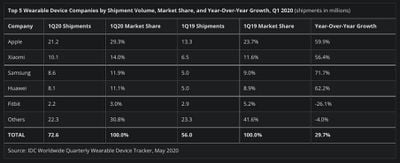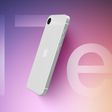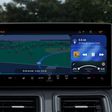Apple maintained its consummate lead in the global wearable products market in the first quarter of this year, based on research conducted by IDC.

According to the report, Apple's lot grew by 13.3 million units, or 59.9 percent year on year, handing it a 23.7 percent share of the market.
Despite difficulties in the supply chain for Apple Watch, the company saw strong results thanks to its Beats and AirPods range (the report treats "hearables" as a subset of wearables).
IDC put the strong demand for AirPods and Beats down to the ongoing health crisis and the increasing number of people working from home who are in need of headphones.
"Consumers were clamouring for these sophisticated earpieces not only for the abilty to playback audio but also to help them increase productivity, as many of them were forced to work from home and sought ways to reduce surrounding noise while staying connected to their smartphones and smart assistants."
Xaiomi came second in place after Apple, with 10.1 million units shipped in the first quater of this year, amounting to 14 percent market share.

Samsung, Huawei, and Fitbit were the other major companies to make up the rest of the wearables market in the report. Global shipments of wearable devices grew 29.7 percent in Q1 2020 compared to Q1 2019, totalling 72.6 million units.
Production of Apple's rumored over-ear wireless headphones is already said to be underway, and Apple's virtual Worldwide Developers Conference in June could be a good opportunity to introduce them.
Apple is also expected to debut Powerbeats Pro in four new Colors soon, so there would appear to be plenty of reasons for Apple to be confident of maintaining its dominance in the wearables market going forward.













Top Rated Comments
And when AirPods were an embarrassing flop according to The Verge’s Nilay Patel?
It all began back in 2001 when Apple should have released a new server, not an overpriced music toy.
Cook kept telling everyone who would listen in early 2017 that Services would double from $24.3B in 2016 to $50B annually by 2020. In 2019, Apple Services were $46.9B, a 16% change from 2018. Apple will be on its way towards beating that goal in FY 2020, as Cook said they would.
Wearables were $12.8B in 2017, $17.38B in 2018 (36% rise), and $24.48B in 2019 (41%) rise, and itself almost doubling like Services did, no doubt fueled by Watch, AirPods/AirPods Pro, and others. iPhones had dropped 14% in 2019 but it was easy to see, if you were looking, that Apple had successfully began and accelerated their revenue diversification. Apple’s blowout 1Q 2020 and better than expected 2Q 2020 Covid affected report still suggest that change is continuing and the iPhone had been doing better than expected. Over the past 3 quarters, analysts were finally waking up and revising their expectations upward, in concert with recognition that Watch, AirPods and now services was leading growth for Apple.
As for “hiding” product data, most all smartphone makers now “hide” individual model data (Samsung included) and only trumpet sales when it suits them (remember Samsung reporting huge first week or month sales, only to later report quarterly or annually sales of mobile devices, especially flagships, would be lacking in revenue and profits?). It’s the quarterly sales, revenue, profits and gross margin which are most important to show a strong business model, and of course, Apple has been much better and stronger at doing that than any other tech company.
I agree they are trying to balance the narrative for investors and analysts alike without revealing too much to competitors who would love to have even a small slice of Apple’s revenue, profits and success. Why else would they copy so much of Apple’s look, design, and experience if not to coattail somehow on Apple.
Profit market share likely 75%+
Apple on a roll here
But, they persisted and it's clearly paid off.